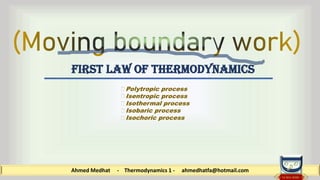Report
Share
Download to read offline

Recommended
Recommended
More Related Content
More from Ahmed Medhat
More from Ahmed Medhat (12)
Recently uploaded
Recently uploaded (20)
The Mariana Trench remarkable geological features on Earth.pptx

The Mariana Trench remarkable geological features on Earth.pptx
Genome Projects : Human, Rice,Wheat,E coli and Arabidopsis.

Genome Projects : Human, Rice,Wheat,E coli and Arabidopsis.
Site specific recombination and transposition.........pdf

Site specific recombination and transposition.........pdf
Human & Veterinary Respiratory Physilogy_DR.E.Muralinath_Associate Professor....

Human & Veterinary Respiratory Physilogy_DR.E.Muralinath_Associate Professor....
Selaginella: features, morphology ,anatomy and reproduction.

Selaginella: features, morphology ,anatomy and reproduction.
Understanding Partial Differential Equations: Types and Solution Methods

Understanding Partial Differential Equations: Types and Solution Methods
GBSN - Biochemistry (Unit 2) Basic concept of organic chemistry 

GBSN - Biochemistry (Unit 2) Basic concept of organic chemistry
Pteris : features, anatomy, morphology and lifecycle

Pteris : features, anatomy, morphology and lifecycle
Cyathodium bryophyte: morphology, anatomy, reproduction etc.

Cyathodium bryophyte: morphology, anatomy, reproduction etc.
Fourth quarter science 9-Kinetic-and-Potential-Energy.pptx

Fourth quarter science 9-Kinetic-and-Potential-Energy.pptx
Major groups of bacteria: Spirochetes, Chlamydia, Rickettsia, nanobes, mycopl...

Major groups of bacteria: Spirochetes, Chlamydia, Rickettsia, nanobes, mycopl...
development of diagnostic enzyme assay to detect leuser virus

development of diagnostic enzyme assay to detect leuser virus
13.pdf
- 1. Ahmed Medhat - Thermodynamics 1 - ahmedhatfa@hotmail.com First law of thermodynamics Polytropic process Isentropic process Isothermal process Isobaric process Isochoric process
- 2. Energy (E) Heat (Q) 𝐻2 − 𝐻1 𝐻𝑔 − 𝐻𝑓 = 𝐻𝑓𝑔 m*C*ΔT m*Cv*ΔT m*Cp*ΔT ሶ 𝑚 * H.V Work (W) T * 𝜔 1 2 𝑘(x2 2 − 𝑥1 2 ) ሶ 𝑊 = 𝑉 ∗ 𝐼 Internal Energy (U) Kinetic Energy (KE) 1 2 𝑚𝑉2 Potential Energy (PE) M*g*z Moving Flow Work P*V ▪Polytropic process ▪Isentropic process ▪Isothermal process ▪Isobaric process ▪Isochoric process Ahmed Medhat - Thermodynamics 1 - ahmedhatfa@hotmail.com
- 3. Ahmed Medhat - Thermodynamics 1 - ahmedhatfa@hotmail.com ▪Polytropic process ▪Isentropic process ▪Isothermal process ▪Isobaric process ▪Isochoric process Expansion and compression work is often called moving boundary work 𝒅𝑾=𝑷×𝒅𝑽
- 4. Ahmed Medhat - Thermodynamics 1 - ahmedhatfa@hotmail.com P=f(V)
- 5. Ahmed Medhat - Thermodynamics 1 - ahmedhatfa@hotmail.com 𝑷𝑉𝑛=𝑪,where n and C are constants. Polytropic process 𝑷1V1 𝑛 = 𝑷2V2 𝑛
- 6. Ahmed Medhat - Thermodynamics 1 - ahmedhatfa@hotmail.com (n=𝜸) 𝑷𝑉𝑛=𝑪 Polytropic process Isentropic process Adiabatic (Q=0) and Reversible (S=C) 𝜸 is the specific heat ratio = 𝑪𝒑/𝑪𝒗 Isothermal process (n=𝟏) Isobaric process (n=0) Isochoric process (n=∞) P v 𝑃𝑉 = 𝑚ℝ𝑇
- 7. Ahmed Medhat - Thermodynamics 1 - ahmedhatfa@hotmail.com Air expanded according to 𝑷𝑉1.33=𝑪 from 5 bar, 227℃ to 1 bar, and then heated at constant pressure to original temperature. Determine total work done and amount of heat transferred Solution 𝑷𝑉𝑛=𝑪 P v 1 2 3 𝑤𝑡𝑜𝑡𝑎𝑙 = 𝑤1:2 + 𝑤2:3 𝑃𝑉 = 𝑚ℝ𝑇 0.287 1 kg 𝑉2 = ? ? 𝑉1 = 0.284 𝑚3 𝑉3 = 1.421 𝑚3 𝑇2 = 335 𝐾 = 62 ℃ 𝑉2 = 0.952 𝑚3 = −505 ∗0.952+101 ∗0.284 1−1.33 + 101 1.421 − 0.952 = +1417.3 𝑘𝐽 𝑎 +47.4 KJ +1369.9 KJ 𝑞𝑝𝑜𝑙= ϒ−𝑛 ϒ−1 * 𝑤𝑝𝑜𝑙 +239.5 KJ 𝑞𝑖𝑠𝑜𝑏𝑎𝑟𝑖𝑐= 𝑐𝑝 ∗ (𝑑𝑇 ) +165.825 KJ